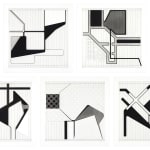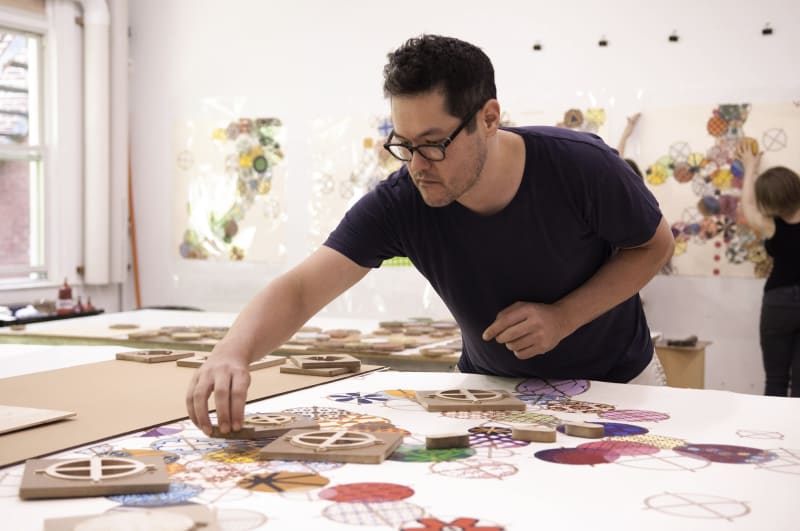Jacob Hashimoto
-
WorksOpen a larger version of the following image in a popup:
 Lemmata Composite
Lemmata Composite
Jacob Hashimoto
Lemmata, 2015Hard Ground Etching and Aquatint
Somerset Satin 300gsm27 1/2 x 27 5/8 inches (each)
(69.9 x 70.2 cm)Edition of 25© Jacob Hashimoto/Durham Press, 2015Further images
-
(View a larger image of thumbnail 1
)

-
(View a larger image of thumbnail 2
)

-
(View a larger image of thumbnail 3
)

-
(View a larger image of thumbnail 4
)

-
(View a larger image of thumbnail 5
)

-
(View a larger image of thumbnail 6
)

-
(View a larger image of thumbnail 7
)

-
(View a larger image of thumbnail 8
)

-
(View a larger image of thumbnail 9
)

-
(View a larger image of thumbnail 10
)

Visit our Viewing Room to learn more.Visit our Viewing Room to learn more.Literature
Durham Press is pleased to present their first project with artist Jacob Hashimoto, Lemmata, a portfolio of five hard
ground etchings with aquatint. The prints, which are available as a set or individually, each measure 27 1/2 x 27 5/8 inches
and are published in an edition of 25.
Each of Hashimoto’s Lemma (a mathematical theorem that validates a larger proof; the singular form of “lemmata”)
resembles a diagram for one of his wall sculptures. Composed of thousands of handmade bamboo-and-paper kites that
have been suspended with strings, these sculptures invite associations with painting and textile. While his diagrams are the
starting point for these kite sculptures, Hashimoto presents the prints as finished artworks themselves. Each image is both
a metaphorical building block – even cornerstone – of a yet to be constructed object as well as the object’s barest, most
essential form. At once complete and preliminary, the Lemmata explore the creative process of how ideas take shape and
progress.
Like Hashimoto’s kite sculptures, the prints are informed by and expand on the landscape genre. Rather than presenting
a single orderly expanse, he creates “collages of different types of optical space,” with references to landscape-based
abstraction, modernist utopian architecture, and virtual environments such as Minecraft and Google Maps. Lemmata’s
precise lines, initially hand-drawn by Hashimoto and transferred to AutoCAD, relate to these computer generated worlds.
Areas of plate tone and aquatint – a much less mechanical process – contrast with the exactness of the etching by revealing marks of hand production. The artist employed both digital and centuries-old techniques, calling attention to past and present representations of landscapes, as well as the technologies that have inspired and propagated them. The prints consider how our notions about landscapes are constantly changing, as is how we understand and interact with our surroundings.
1of 6Viewing rooms
-

Jacob Hashimoto | The Vanishing Point of Night – The Secret Lives of Comets Monoprints
2022 -

Jacob Hashimoto | The Necessary Invention of the Mind
2020 -

Jacob Hashimoto | Index I and II
2017 – 2018 -

Jacob Hashimoto | Love’s Great Mystery, Ontological and Absolute
2017 -

Jacob Hashimoto | This Ever-Fragile Balance Series
2024 (in production)
BiographyB. 1973, GREELY, COLORADO
Jacob Hashimoto uses sculpture, painting, and installation to create complex worlds from a range of modular components: bamboo-and-paper kites, model boats, even Astroturf-covered blocks. His accretive, layered compositions reference video games, virtual environments, and cosmology, while also remaining deeply rooted in art-historical traditions—notably, landscape-based abstraction, modernism, and handcraft.Hashimoto has been collaborating with Durham Press since 2015, producing editions and monoprints featuring intaglio, woodblock, and screenprint. His prints often reference his kite works, reflecting on and reimagining aspects of his process—from the blueprint-like imagery of Lemmata (2015), to the nearly two hundred individual kite images in The Hashimoto Index (2018), to the playful compositions of The Necessary Invention of the Mind (2020).Represented by Rhona Hoffman Gallery, Chicago; Studio la Città, Verona, Italy; Galerie Forsblom, Helsinki; Makasiini Contemporary, Turku, Finland; and Ronchini Gallery, London, Hashimoto has been exhibiting internationally since the late 1990s. In addition to numerous solo shows at the aforementioned galleries, he has been the focus of individual presentations at the Museum of Contemporary Art, Chicago (1998); Tacoma Art Museum, Washington (2004); San Jose Museum of Art, California (2004); Mary Boone Gallery, New York (2007, 2009, 2011, and 2016), MACRO—Museo d’Ate Contemporanea di Roma, Rome (2010); Museum of Contemporary Art, Los Angeles (2014); SITE Santa Fe (2018–19); and Crow Museum of Asian Art, Dallas (2018–19). He has produced site-specific installations for locations ranging from Governor’s Island in New York to Willis Tower in Chicago.Hashimoto’s work is in private and public collections internationally, including the those of Cornell Tech, New York; Los Angeles County Museum of Art; Microsoft Corporation; Schauwerk, Sindelfingen, Germany; Jordan Schnitzer Family Foundation; Tacoma Art Museum, Washington; University of Chicago; and the U.S. Department of State. -
(View a larger image of thumbnail 1
)















